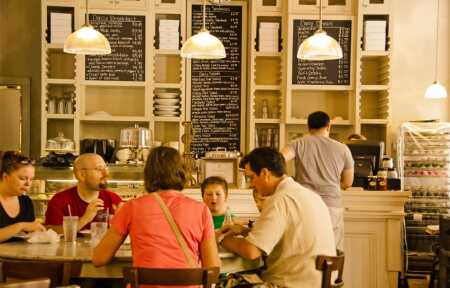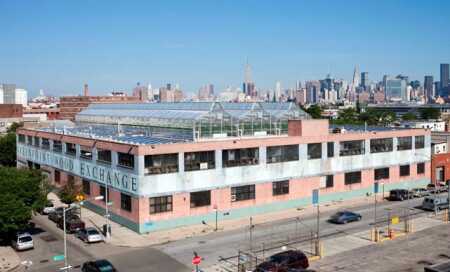What is green, growing, healthy, and rapidly adding value to real estate? Attendees of the ULI 2015 Fall Meeting in San Francisco learned that the answer to that question is locally grown food. From rooftop gardens, to edible landscaping, to farm-focused developments, to urban food markets, to breweries in once-derelict industrial spaces, food is transforming marginal real estate and underused spaces in new and dramatic ways.
In the United States, food has long been taken for granted, especially where it is grown and how it is sourced. But as a growing number of developers are learning, food can have a big impact on the success or failure of new development, particularly when it is part of a larger place-making and revitalization strategy.
“Food, Glorious Food: The Growing Power of Food in Cities and Real Estate Projects” showcased numerous examples of how food is becoming an important part of not just our diets, but also our developments. Moderated by California marketing expert Sandra Kulli, this popular session provided food for thought on the role of farms and food as a real estate amenity, a community builder, and a project differentiator.
The session kicked off with an overview of the many ways that developers are using food to grow profits while attracting buyers, tenants, and customers. These projects included Serenbe, a farm-centric community outside Atlanta. Developed by restaurateur-turned-developer Steve Nygren, Serenbe features a 25-acre (10 ha) organic farm, New Urbanist design, and three restaurants, all featuring farm-to-table dining.
Next up was the market at Pinehills, Massachustts. The Pinehills, the largest master-planned community in New England, includes a 13,000-square-foot (1,200 sq m) market that features locally grown fruits and vegetables. It has become a regional destination and a social hub for the residents of the community.
The presentation also featured food trucks, rooftop farms, and derlict buildings transformed into breweries and distilleries. Greenpoint Manufacturing and Design Center (GMDC), the largest nonprofit industrial developer in New York, has rehabilitated seven industrial buildings in Brooklyn for small manufacturing enterprises, artisans, and artists. Its newest project includes a rooftop farm that grows vegetables and herbs for local restaurants.
Gotham Greens, another New York City–based company, is now operating three commercial-scale rooftop greenhouses in Brooklyn and Queens. The company’s flagship greenhouse in the Greenpoint neighborhood of Brooklyn measures over 15,000 square feet (1,400 sq m) and annually produces more than 100 tons (90 metric tons) of fresh leafy greens. All products are grown using recirculating irrigation systems that capture water for reuse. Electrical demands are offset by on-site solar arrays and high-efficiency design features, including LED lighting, advanced glazing, passive ventilation, and thermal curtains that sharply reduce electrical and heating demands. In addition, the rooftop farm reduces energy use by insulating the building below. Whole Foods in Brooklyn is now working with Gotham Greens to incorporate a solar-powered hydroponic farm on the grocer’s rooftop.
Other projects showcased by session moderator Kulli included a pop-up store in Seattle that uses used coffee grounds from Starbucks to grow gourmet mushrooms for restaurants, a community garden behind the centerfield wall at the San Francisco Giants ballpark that grows food for two ballpark restaurants and serves as an outdoor classroom for schoolchildren, and the revitalized Grand Central Market in Los Angeles, which was named America’s “10th Best Restaurant” by Bon Appétit magazine, even though the market is not new and it is not a restaurant.
The short stories culminated with the story of Century City Mall in Los Angeles, which is undergoing an $800 million refurbishment with a new focus on food and dining. The new mall anchor is Eataly, which Westfield describes as the Apple store for food. With Amazon and other online retailers eating into sales by brick-and-mortar retailers, Westfield is betting on food. As one veteran California real estate developer said, “You can’t eat online.”
Following her inspirational overview, Kulli introduced Susan Watts, a South Carolina developer. Watts, a vice president, WestRock Land and Development, introduced the audience to Summers Corner, a new master-planned community that has branded itself around food, gardens, and gracious southern living. Summers Corner is successfully using Charleston’s “foodie status” and Summerville’s “Flowertown” motto to differentiate their product in a crowded marketplace.
Besides having a great web and social media presence, Summers Corner used an old Thomas Jefferson approach, “the Jeffersonian dinner.” According to Watts, Summers Corner hosted a number of small (ten- to 12-person) dinners for Charleston-area thought leaders in the areas of community building, local food, and the arts. The dinners featured wine, glorious local food and used local culinary arts faculty chefs to introduce the new community and encourage discussion of subjects that they shared in common.
Summers Corner also took an innovative approach to using a community garden as a development amenity. “We invited the Clemson Extension Service–Master Gardener program to be housed at Summers Corner. They jumped at the chance, and are now housed in a Victorian cottage and have 12 large planting plots. The beauty of their being within our community is that it provides instant activity. People coming and going—real people, doing real gardening.”
Playing off the food and dining culture of nearby Charleston, Summers Corner also established a real café, serving beer, wine, coffee, and soup and sandwiches as part of its sales and information center. The café attracts people from surrounding neighborhoods and reinforces Summers Corner’s Low Country lifestyle revolving around food and friendliness.
The final two presenters were John Woodhead, director of community and economic development for the city of Anaheim, California, and Amy Parsons, executive vice-chancellor of Colorado State University.
Anaheim is, of course, known as the home of Disneyland and the California Angels baseball team. However, the city was originally founded by a group of German immigrants who planted grapes and made wine. It was also known for making things and growing other crops like hops, nuts, and citrus fruits. In more recent years, Anaheim, like other southern California communities, was overwhelmed by auto-oriented suburban-style development.
According to Woodhead, Anaheim wanted to get back to its DNA of making things and growing things. A big part of this effort was reclaiming its historic core and adding vitality through new housing and mixed-use downtown development. However, the catalytic project that transformed Anaheim was a public/private partnership to revitalize the Packing House District.
The Anaheim Packing House is a 42,000-square-foot (3,900 sq m) gourmet food hall in downtown that opened in 2014. It is located in a renovated 1919 former Sunkist fruit-packing house in a handsome Spanish colonial–style building. Capitalizing on the trends of fresh and local food, the Packing House provided a badly needed community gathering place and was a success from day one, when it attracted 5,000 people to its grand opening.
Today, the Packing House is the centerpiece of a larger district that features a spacious central atrium with communal dining surrounded by cafés and kiosks of varying sizes. It also has an outdoor picnic garden, a building-length outdoor dining porch, and an outdoor market and park. An adjacent building houses the Anaheim Brewery and a gourmet burger restaurant. The two-acre (0.8 h) Farmers Park is a vibrant community gathering place that hosts a weekly farmers market, outdoor movies and concerts, a German Christmas market, and other events.
Parsons, the final presenter, laid out Colorado State University’s efforts to transform the National Western Center in north Denver into a vibrant year-round destination. The university has embarked on a multiphase effort to reimagine the facility, which is currently used for livestock shows, as an equine sports medicine center, a hands-on environmental education center, a performing and visual arts space, as well as a classroom, laboratory, and food systems exploration center.
Urban farmers and real estate developers may seem like an odd couple, but this session made it clear that farm-centric development and food-focused projects are growing in new and unexpected ways. Urban agriculture is more than a way to grow vegetables; it is also a way to grow profits and build community. This session clearly illustrated the growing power of food in real estate.
Edward T. McMahon is a ULI senior resident fellow and the Charles Fraser Chair for Environmental Policy.





![Western Plaza Improvements [1].jpg](https://cdn-ul.uli.org/dims4/default/15205ec/2147483647/strip/true/crop/1919x1078+0+0/resize/500x281!/quality/90/?url=https%3A%2F%2Fk2-prod-uli.s3.us-east-1.amazonaws.com%2Fbrightspot%2Fb4%2Ffa%2F5da7da1e442091ea01b5d8724354%2Fwestern-plaza-improvements-1.jpg)


